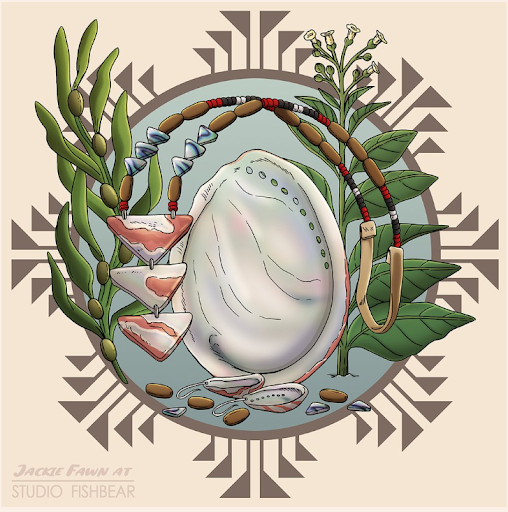Overview
Abalone: Indigenous Beauty

Authors and Contributors:
- Save California Salmon
- Phil Albers (Karuk)
- Michaela Ward
- Carrie Tully
- Cody Henrikson
- Edited and Formatted by Maggie Peters (Yurok/Karuk), NASMC Learning Specialists Humboldt County Office of Education
Grades: 3-5
Suggested Amount of Time: 90 minutes or two 45 minute sessions
Curriculum Themes:
- History
- Cultural Strengths
- Relationship to Place
Learning Goals
- Define nearshore marine environments and their connections with Indigenous Californians, coastal and inland, with an emphasis on abalone.
- Identify and understand some of the traditional foods from the ocean and estuaries within TEK.
- Identify how impacts to the environment affect Indigenous Peoples and marine life.
Lesson Overview
In this lesson, students will explore the fascinating world of abalone, sea creatures that live along the rocky coasts of California. They will learn about the abalone’s body parts and where it lives, discovering how these animals are an important part of the ocean habitat. The lesson will also include a traditional story from the local tribes of Northwestern California, helping students understand how Indigenous people have cared for and respected abalone for many generations through their cultural knowledge and traditions. Students will learn about the history of abalone populations, including how and why their numbers have gone down over time due to factors like overfishing, pollution, and changes in the environment. Through this lesson, students will connect science and traditional ecological knowledge, gaining a deeper appreciation for the abalone and why it is important to protect them today.
Teacher Background
Before teaching this lesson, it is important for educators to familiarize themselves with the local ancestral territories of the Indigenous peoples whose traditional lands are along the Northwestern California coast. This area is home to many tribes, such as the Yurok, Karuk, Tolowa, and Wiyot, each with rich cultural connections to the coastal environment and marine life, including abalone. Understanding the significance of these ancestral territories fosters respect and appreciation for the Indigenous communities and their deep-rooted relationship with the land and sea.
Abalone are marine mollusks with distinctive, colorful shells and play an important ecological role in coastal habitats. Along the Pacific Northwest California coast, abalone have been a vital resource for Indigenous peoples for thousands of years. Tribes harvested abalone sustainably for food, tools, jewelry, and trade. They developed traditional ecological knowledge (TEK) that guided respectful harvesting practices and protected abalone populations. Stories and cultural teachings often highlight the connection between people, animals, and the environment.
In recent history, abalone populations have dramatically declined due to overharvesting, habitat degradation, pollution, climate change, and disease. This decline threatens not only the species but also the cultural traditions and ways of life of coastal Indigenous communities.
Educators should approach this lesson with cultural humility, honoring Indigenous voices and knowledge alongside scientific facts. Preparing by reading about local tribes’ history and TEK related to abalone will enrich the lesson and help students appreciate the important intersection of culture, ecology, and conservation.

